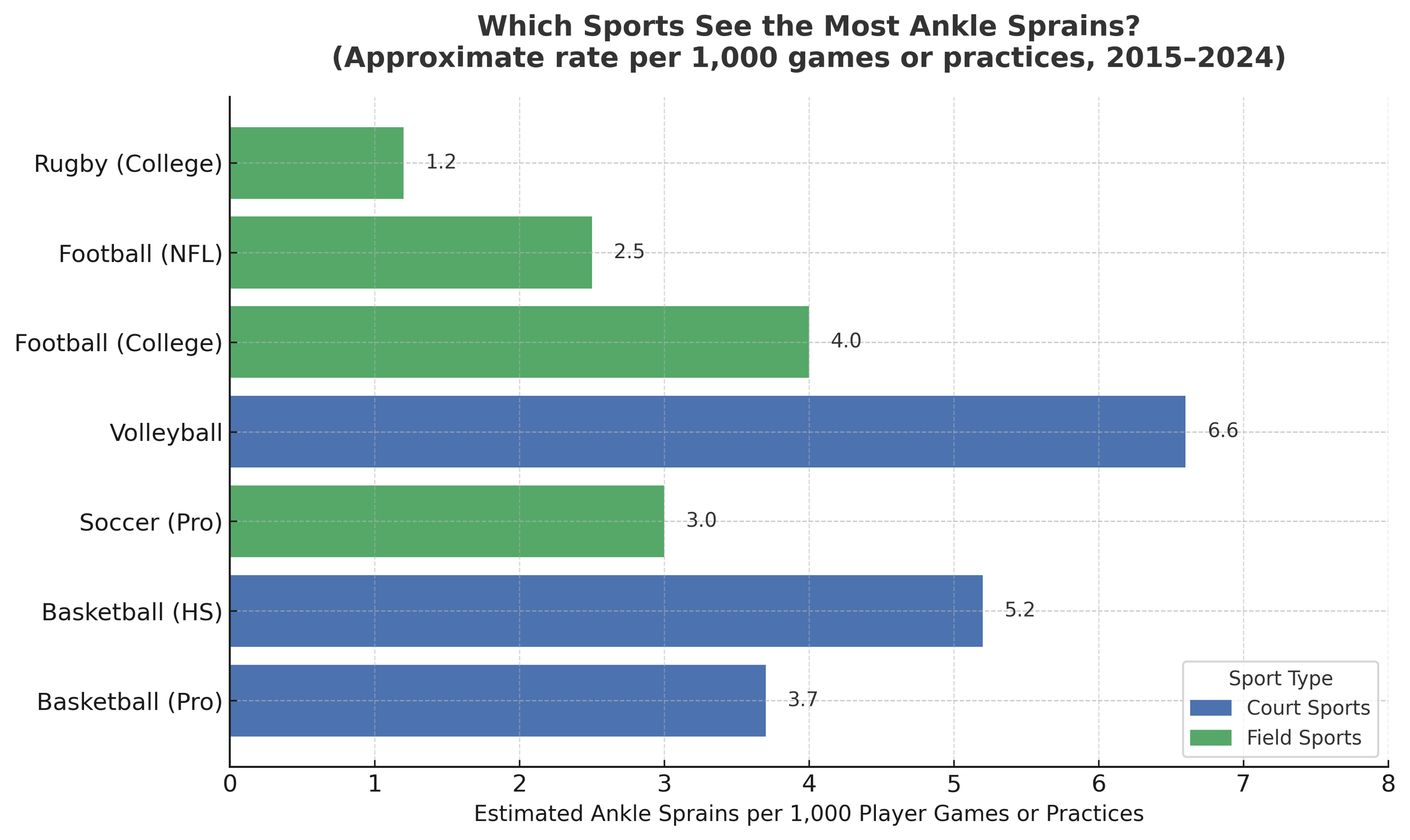What These Numbers Mean for You
The chart above isn’t just about numbers — it’s about how your sport stacks up in ankle risk and what that means for keeping you on your feet.
Court sports (like basketball and volleyball) lead the pack for ankle sprains because of the constant jumping, cutting, and landing on other players’ feet. Quick direction changes and rebounds make these sports a perfect storm for rolled ankles.
Field sports (like soccer, football, and rugby) cause more contact-related ankle injuries — think awkward tackles, slippery grass, and high-velocity collisions. These injuries often involve the syndesmosis (“high ankle”) and can sideline athletes longer.
Repetition matters: The more you play, the higher your exposure risk. That’s why professionals and year-round athletes report higher rates than casual players.
Prevention pays off: Studies consistently show that ankle braces, taping, and neuromuscular training can cut sprain rates by 40–50%.
Rehab isn’t optional: Once you’ve sprained an ankle, skipping rehab doubles your chances of another injury — and long-term instability can linger for years.
Bottom line: No matter your sport, ankle strength and balance training aren’t just accessories — they’re your best defense against the most common injury in athletics.
Every ankle sprain tells a story — but at our clinic, we make sure it doesn’t become a recurring chapter. While most people think a sprain just needs rest and time, research shows that without proper rehab, up to 70% of athletes develop lingering weakness or instability. That’s where physical therapy makes the difference.
At our facility, recovery isn’t a one-size-fits-all process. We combine evidence-based rehab with sport-specific retraining to restore balance, strength, and movement confidence — so you can return not just to play, but to peak performance.
How We Address Ankle Sprains In Physical Therapy:
Early Phase: Calm the Injury, Set the Foundation
In the first stage, our priority is to reduce swelling, relieve pain, and restore gentle motion. We also strengthen the joints and muscles above the ankle — the hips, knees, and core — to keep your body balanced during recovery.
We introduce light neuromuscular and proprioceptive training early to keep your ankle connected to your brain’s balance system.
Treatments that accelerate this phase include:
MyACT Piezowave therapy (shockwave treatment) to boost circulation and healing.
Targeted massage and voodoo band compression to reduce swelling and stiffness.
Dry needling to relieve pain and improve muscle activation.
24/7 compression sleeve use to manage swelling and promote recovery.
Mid Phase: Rebuild Strength and Control
Once swelling subsides and motion returns, we shift focus toward building ankle strength, balance, and coordination.
This stage bridges basic movement and athletic function — restoring your ankle’s ability to stabilize under everyday and athletic demands.
Our focus:
Progress range of motion and resistance training.
Introduce balance and proprioception drills on stable and unstable surfaces.
Continue managing any residual swelling to ensure smooth progress.
End Stage: Return to Power and Performance
The final stage is where athletes regain their explosiveness, agility, and sport-specific readiness.
We integrate plyometrics, cutting, and directional drills that mimic your sport’s real-world challenges — basketball jumps, soccer pivots, football sprints, and more.
The goal: Build a resilient ankle capable of handling rapid movements, unpredictable landings, and high-impact demands — without fear or instability.
Ready to Start Your Recovery?
Don’t let an ankle sprain keep you on the sidelines longer than it should. Whether you rolled your ankle last week or have been dealing with chronic instability for years, the right physical therapy approach can make all the difference.
Schedule your ankle recovery evaluation today and take the first step toward getting back to the sport you love — stronger than before.

